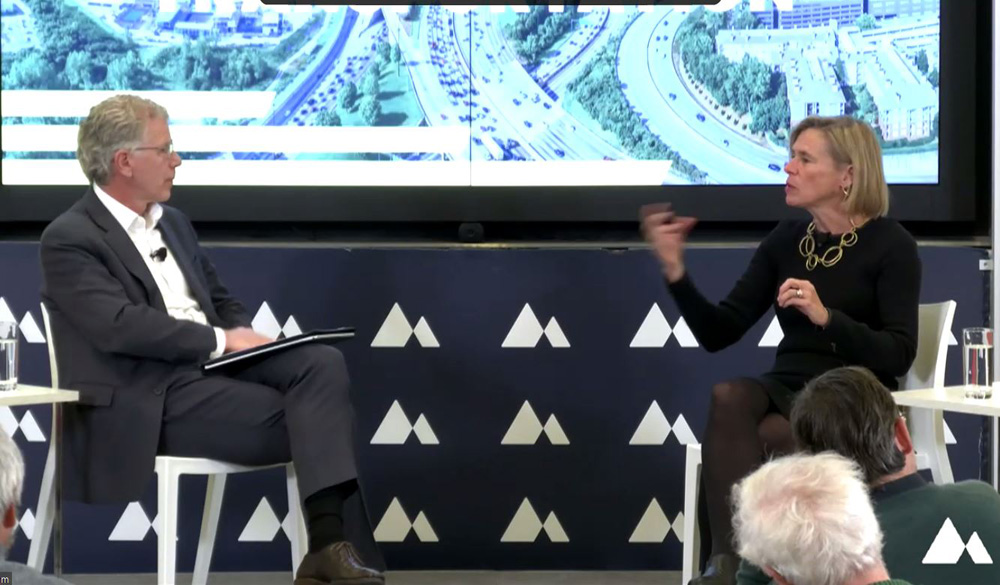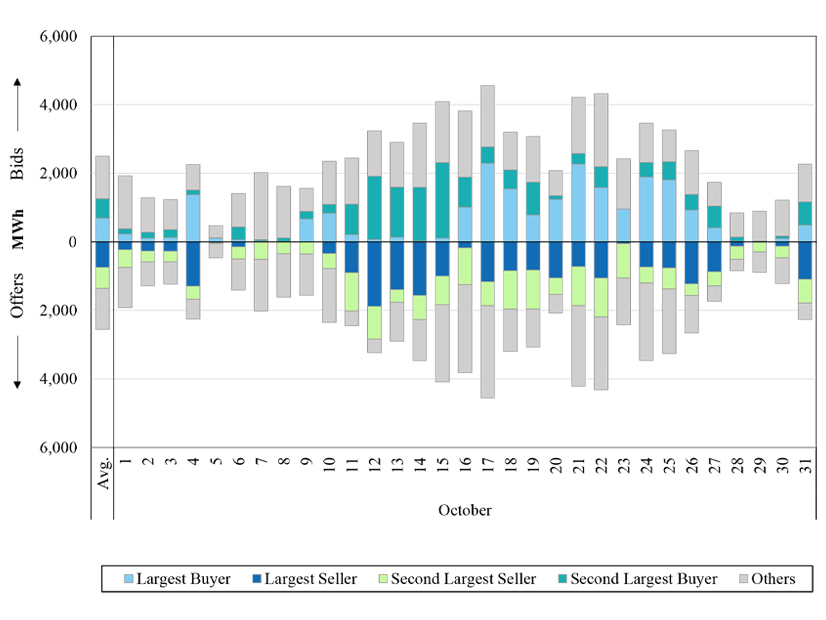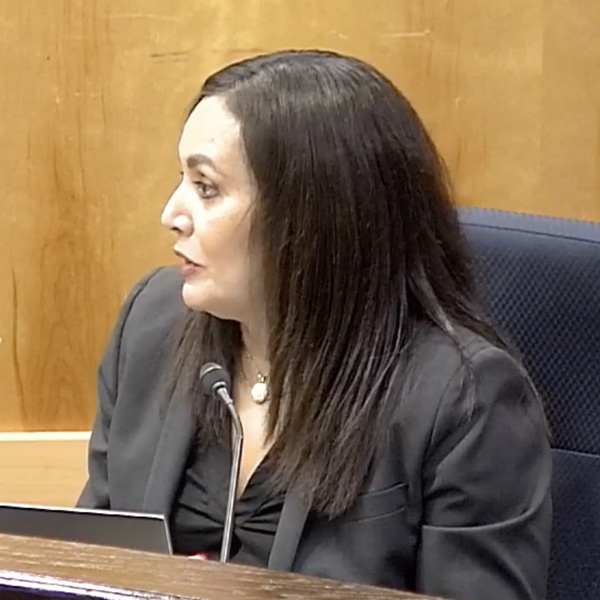When Cathy Zoi joined charging company EVgo as its CEO in 2017, only a couple of electric vehicle models were for sale, and their range was limited to about 70 miles.
Founded in 2010 as a unit of NRG Energy, EVgo had only 50 employees and no revenue model. By the time Zoi retired from the company in November, it had about 300 employees, and more than 40 EV models were for sale in the U.S., many with a range over 300 miles. Although EVgo, now owned by LS Power, has yet to earn a profit, Zoi is bullish on the industry’s future.
“Now, there’s not a car company that is not investing significantly in electrifying its offerings — to the tune of a trillion dollars globally,” she said in an interview with Resources for the Future CEO Richard G. Newell on Nov. 29 as part of its Policy Leadership Series of webinars. “That is a once-in-a-century transformation of a major sector that is happening present tense. … I did not anticipate that amount of commitment by private capital would happen so quickly. And that’s really, really heartening.”
The industry’s biggest challenge now is creating the charging infrastructure needed to make new converts confident they won’t get stranded without power, Zoi said. “What is probably underestimated by everybody was the complexity of building a new ecosystem,” she said.
Zoi told Newell and an audience in D.C. she is unfazed by reports of automakers pulling back on their EV plans.
“I think it’s an ephemeral thing,” she said. “If they’re pulling back, they’re pulling back from a slope that was like this,” she said, pointing steeply upward, “to a slope that was like that” — less steep. “It’s still very, very fast compound annual growth rates. You know, maybe the new model was going to come out in Q1 next year, [and] it’s going to come out in Q3 instead.”
Nor is she concerned that a Republican president or Congress will seek to halt EVs’ growth, saying elected officials will not want to lose the jobs resulting from the EV and battery factories that have been announced since the Inflation Reduction Act and Infrastructure Investment and Jobs Act.
“There were elected members of office in this town that might have been hostile to clean energy because it’s environmental. And yet, their constituents — the farmers of Iowa — are making more money out of having wind turbines on their property than they are out of the corn they’re selling and the soybeans they are growing,” she said.
“On the consumer side, I have not talked to a driver who has experienced an EV and doesn’t adore it,” she continued. “And this is why you’ve got the market growing in Texas, in Florida, as quickly as it is. They are really great products. They’re fun to drive; it’s a better-performing technology. And you know, people say, ‘I love not having to go to a gas station anymore.’”
Reality check: While EVs have fewer moving parts than internal combustion engine (ICE) vehicles, and thus should need fewer repairs, Consumer Reports says EV owners continue to report far more problems than owners of conventional cars or hybrids. Many drivers of EVs other than Teslas have complained about nonworking chargers. S&P Global Mobility says half of EV owners — excluding those with Teslas — go back to ICE vehicles as either a replacement car or a second vehicle for their household.
Scaling Up
Zoi is optimistic the industry can meet the Biden administration’s target of making EVs half of new car sales by 2030.
The U.S., which has 30,000 fast chargers, will need 200,000 to 300,000 by 2030, she said.
EVgo — which has 3,400 DC fast-charging stalls in operation or under construction at more than 950 locations nationwide — has identified about 10,000 sites for additional chargers, assuming available capital.
“So I can tell you on the charging side, we’re up to the task. … But as I mentioned, it’s a whole ecosystem,” she said. That means utilities must upgrade distribution grids, and carmakers must transform from ICE vehicles to EVs. “So it’s ambitious, but achievable.”
Below are four things Zoi learned in her time at EVgo, with implications for the industry:
-
People like to top off at the store even if they have home chargers.
The demand for DC fast chargers has grown faster than expected, Zoi said.
“We thought the whole idea was if you can charge at home, you’re only going to charge at home. Turns out that’s not the case. If you have a charging station conveniently located at your grocery store, people are topping up there. It’s a good parking space. [They will] spend five bucks while they’re going to get their weekly groceries.”
Another factor: “The … EVs that are being sold, [their] batteries are bigger, and they’re heavier. And so they’re a little less efficient … than we originally forecast, which means that the folks need to fill up more frequently.”
EVgo’s national use rate — the percent of time a charger is in use — is more than 15%, with some stations, such as one in Brooklyn, in use more than 50% of the time.
-
Only some customers are price responsive.
The company has seen a wide range of price elasticity as it has adopted time-of-use pricing.
“Some of our drivers are very price responsive, like our rideshare drivers. Others do not care at all,” she said.
After joining the company, Zoi imposed a rule that it should make a profit on every kilowatt-hour dispensed, which required it to abandon its single national price.
“In order to not lose money in San Diego … we had to double our rates,” she said. “And the demand dipped a little bit for a couple of weeks, and then it went right back up.”
The average out-of-pocket spend per charging session is about $10, not including monthly subscription fees of up to $13. “So it’s two Starbucks things, right? It’s just not that much money. And you come out and you’ve got electrons in your car, and off you go, and you feel great.”
-
It takes a long time to plug into utility distribution lines.
It takes between six and 18 months from site identification to having the station go live, Zoi said, far from hopes of a six-month turnaround.
“Because we’d like to build stations with at least 10 stalls, now it almost always requires a service upgrade, which means that the utilities buy a transformer … and the site host has to allow the utility access to the site. … It turns out that landlords — we don’t own the land — don’t like utilities tromping on their [property]. And then at the back end, in order for a station to go live, the utility has to come and do the final inspection before we enter. And we are often in the queue for something like six, eight, 12 weeks until they show up.”
EVgo is trying to shorten the timeline by providing utilities with its siting plans for the next 18 to 24 months. “We say this is where we’d like to build … and sometimes they say, ‘Oh my gosh, don’t build here, because we’re really constrained,’ or ‘We’re not going to upgrade that local connector until 2027.’ But they usually say, ‘Great. Now we’ll order transformers for all these locations.’
“As we get into larger, heavy-duty trucks being electrified, those are going to be megawatt[-scale] charging stations that need to be integrated into utility plans — like in a big way.”
-
Chevron needs to improve its menu.
The biggest share of EVgo’s $35.1 million in revenue in the third quarter — up 234% year-over-year — was from retail chargers. It has partnerships with shopping center owners; Target; Chase Bank; Lowe’s; supermarkets Kroger, Safeway and ShopRite; and convenience store chains Sheetz and Wawa.
“We like to build where people are anyway. … So you can just plug in, go do something else and come back, and the car’s charged,” Zoi said.
It is also building depots with 20 or 30 stalls for fleet customers. And on highways, it has a partnership with Pilot Flying J truck stops for “white label” chargers owned by Flying J and built and maintained by EVgo.
And it’s experimenting with gas stations through 14 Chevron locations in California.
“I always used to joke with them … ‘You guys are going to need to improve the quality of your coffee if you’re going to get people to want to stay. Because we also partner with Whole Foods. And would you rather [hang] at Whole Foods, or [eat] beef jerky at Chevron?’”


